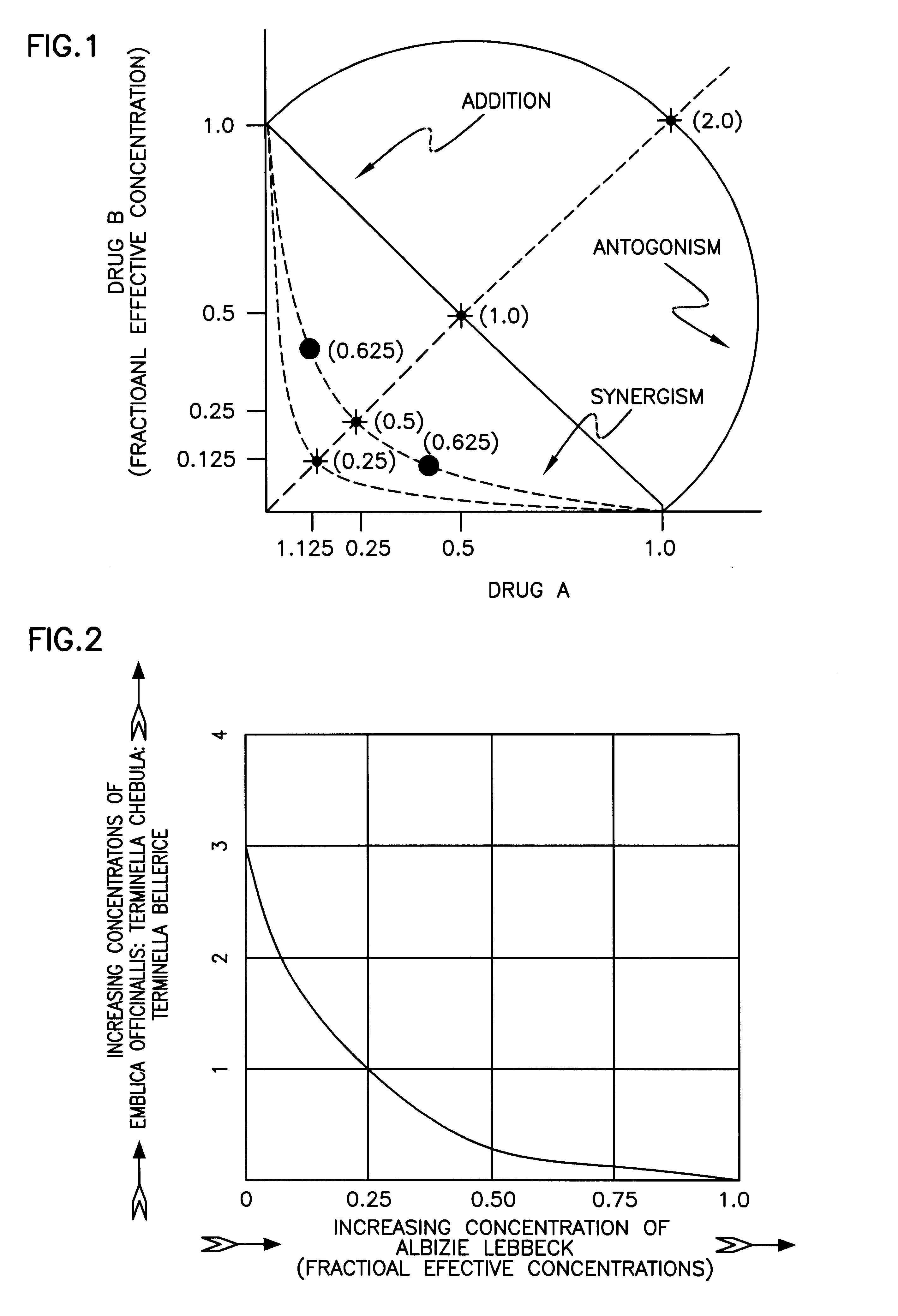Herbal composition having antiallergic properties and a process for the preparation thereof
a technology of antiallergic properties and herbal compositions, which is applied in the field of herbal compositions having antiallergic properties and a process for the preparation of them, can solve the problems of affecting the immune system,
- Summary
- Abstract
- Description
- Claims
- Application Information
AI Technical Summary
Benefits of technology
Problems solved by technology
Method used
Image
Examples
example-2
An amount of 115.5 gms (33% w / w) of Terminalia chebula, 115.5 gms (33% w / w) of Terminalia bellerica, 1.75 gms (0.5% w / w) of Albizia lebbeck, 115.5 gms (33% w / w) of Emblica officinalis, 0.58 gms (0.16% w / w) of Piper longum, 0.58 gms (0.16% w / w of Piper nigrum and 0.58 gms (0.16% w / w) of Zingiber officinale were blended thoroughly. The resulting mixture was dried at a temperature in the range of 55 to 60.degree. C. under vacuum. This composition was made into powder having mesh size of 25 mesh. This composition in a dose of 350 mg can be used as a single or multiple doses for the treatment of allergic conditions as per the requirement
This composition for convenience is henceforth referred to as NR-A1
example-3
An amount of 100 gms (30% w / w) of Terminalia chebula, 100 gms (30% w / w) of Terminalia bellerica, 25 gms (8% w / w) of Albizia lebbeck, 100 gms (30% w / w) of Emblica officinalis, 1.66 gms (0.66% w / w) of Piper longum, 1.66 gms (0.66% w / w) of Piper nigrum and 1.66 gms (0.66% w / w) of Zingiber officinalewere blended thoroughly. The resulting mixture was dried at a temperature in the range of 55 to 60.degree. C. under vacuum. To this mixture, 220 gms of a mixture of maize starch, pregelatinised starch and dicalcium phosphate (taken in equal quantities) is added as excipients and mixed thoroughly. The composition obtained is filled in hard gelatin capsules. Each capsule contains 330 mg of the active ingredients and can be used as a single or multiple doses as per the requirement for the treatment of allergic conditions. This composition for convenience is henceforth referred to as NR-A2
example-4
An amount of 56.25 gms (15% w / w) of Terminalia chebula, 56.25 gms (15% w / w) of Terminalia bellerica, 187.5 gms (50% w / w) of Albizia lebbeck, 56.25 gms (15% w / w) of Emblica officinalis, 6.25 gms (1.67% w / w) of Piper longum, 6.25 gms (1.67% w / w) of Piper nigrum and 6.25 gms (1.67% w / w) of Zingiber officinale were blended thoroughly. The resulting mixture was dried at a temperature in the range of 55 to 60.degree. C. under vacuum. To this mixture, 225 gms of a mixture of maize starch, pregelatinised starch and dicalcium phosphate (taken in equal quantities) as excipients and 0.1 gm of methyl paraben sodium as preservative are added and mixed thoroughly The composition obtained is compacted into tablets by conventional method. Each tablet contains 375 mg of the active ingredients. The tablet can be used as a single or multiple doses as per the requirement for the treatment of allergic conditions. This composition for convenience is henceforth referred to as NR-A3
Each of the above said f...
PUM
| Property | Measurement | Unit |
|---|---|---|
| Fraction | aaaaa | aaaaa |
| Fraction | aaaaa | aaaaa |
| Fraction | aaaaa | aaaaa |
Abstract
Description
Claims
Application Information
 Login to View More
Login to View More - R&D
- Intellectual Property
- Life Sciences
- Materials
- Tech Scout
- Unparalleled Data Quality
- Higher Quality Content
- 60% Fewer Hallucinations
Browse by: Latest US Patents, China's latest patents, Technical Efficacy Thesaurus, Application Domain, Technology Topic, Popular Technical Reports.
© 2025 PatSnap. All rights reserved.Legal|Privacy policy|Modern Slavery Act Transparency Statement|Sitemap|About US| Contact US: help@patsnap.com

